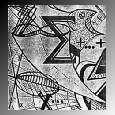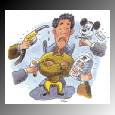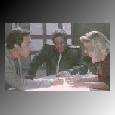|
Argument
has traditionally been closely associated with language
and, even more strongly with reasoning. Recently this has
been extended to cover the wider notion of communication
between people. This has been exemplified in work as
varied as that of Balthorp (1979), O’Keefe (1982),
Willard (1983, 1989), and Eemeren and Grootendorst (1986).
Certainly, instances of argument that are spoken or
written by persons in order to effect some difference in
another person form the most obvious instances of
argument. Beyond that non-verbal communication or
contextual ramifications tend to be included only insofar
as they are linguistically explicable (D. O’Keefe,
1982). The assumption is that to be linguistically
explicable is a necessary condition of being rational, and
what, after all, must be rational if not an argument?
The
difficulty with this approach is that if we are concerned
with how people do argue, with what sorts of material,
evidence, modes of communication, manoeuvres, fallacies,
and what have you people actually do draw upon then we
must go beyond the rational. There are ways around this.
We can, for example, change the sense of the word
“rational” and relativize it so that whatever a
field/group/individual allows as reasonable argumentative
input is ipso facto, rational. Frankly, I
have no objection to this approach other than a strong
feeling that the word has a history and tradition that
creeps in even when applied relativistically. This sense,
the sense of being reasoned, linear, orderly is the one
that strikes me as being harrow and restrictive. This is
the sense applied in such admonitions as, “I’m not
going to argue with you if you can’t argue
rationally.”
In
this sense of the word, "‘irrational" is often
used as an honorific, and more importantly, as a way of
negating and/or trivializing modes of argument not in
keeping with one arguer’s precepts. This sense requires
the rational person to think in a certain, generally
logical, way and adhere to standards of evidence,
deduction, and induction established by the scientific,
rationalist, male tradition. Other forms of argument are
1ooked down upon by the protectors of this tradition and
never so forcefully as when on the losing aide of an
argument.
In
order to isolate this sense of "rational" I will
use the term "logical". I do not, by using this
term, mean to indicate that the arguments so-called are
deductively correct or even intended to model deductive
arguments. Rather, it is intended to indicate not merely a
respect for orderliness of presentation, but also a
subscription to a certain set of beliefs about evidence
and sources of information.
I
want to urge an expansion of our modes of argument beyond
the logical. We need to include modes of evidence,
warrant, backing and presentation that allow us to
identify forms of argument that are actually used as
opposed to those that one particular group, even a group
of argumentation theorists, believes ought to be used. In
thereby separating the normative and descriptive elements
of logicality we cease to condemn when we should be
describing.
I
suggest that arguments can be categorized by not one, but
four, modes. These modes are, in addition to 1) the
logical, 2) the emotional, which relates to the realm of
feelings, 3) the visceral, which stems from the area of
the physical, and 4) the kisceral (from the Japanese term
“ki” meaning “energy”) which covers the intuitive
and non-sensory arenas. At its most extreme this view
holds that arguments may be given (almost) wholly within
one mode and not be at all susceptible to those methods of
argument analysis pertaining to other modes. On this
interpretation of the view a kiss, a look, a touch, a
feeling, may be an argument provided it is communicated
and used to convince or persuade. A more cautious
statement, using D. O’Keefe’s (1982) terminology,
allows that any argument-2 will (possibly) contain
arguments-1 from various modes. Further, to attempt to
reduce these all to the logical is prejudiced
reductionism.
Before
continuing it is important to clarity two terms basic to
my thesis. The first is "argument", the second
"mode." For "argument" I will begin
with Willard’s definition, most recently restated in A
Theory of Argumentation (1989:1): “Argument”
is a form of interaction in which two or more people
maintain what they construe to be incompatible
positions.” Explicating this, Willard says (1989:92)
that arguers, “use any or all of the communication
vehicles available to them…once we have an argument anything
used to communicate within it is germane to an analysis of
how the argument proceeds and how it affects the
arguers.” In short, we have to worry less about the
necessary and sufficient conditions of argument and more
about what people who are arguing actually do.
Arguments
can be classified in as many ways as there are scholars to
classify them. One common way is to describe an argument
as logical or not. An argument that takes its information,
e.g., warrant, backing, evidence, from traditional
rationalist sources, and which, in addition, is or can be
put into traditional rationalist form, viz., linguistic,
is said to be in the logical mode, realm or form. What is
crucial is not that there is anything wrong with the
logical mode, but rather that there are others as well.
Indeed, the logical is only pre-eminent because most
argumentation scholars are highly trained in that mode and
value it above all others. Most of our arguments, however,
do not, in fact, follow a particularly logical model, but
rather involve various modes at various times.
I
would now like to turn from general issues to the specific
explication and exemplification of the four modes of
argument. Let me begin with an example that is apparently
in the logical mode, and, indeed, follows an identifiable
logical pattern.
|
Example
1
Harry held a finger over his lips to
signal for silence. He pointed to the door with
his revolver. “He’s in there,” he said to
Jane.
“How can you be sure?” she queried.
“He
had to take the left or right door before, and
they both lead into that room there.”
“O.K.,
then,” Jane replied, “I’m ready when you
are.” |
 |
The
reasoning with which Harry reassures Jane is classically
rational, and follows fairly closely the pattern known as
v-Elimination or Disjunctive Syllogism in a natural
deduction system. The pattern is as follows.
|
Example
2: A
v B, A Þ
C, B Þ
C ÷
C
|
 |
In
Example 1, let A be, “he took the right door,” B be,
“he took the left door”, and C be “he’s in that
room”. Without too much difficulty we can see the
connection. This is helpful in understanding the
persuasive force of Harry’s argument. Given, as we
witnessed, that Jane accepted the three premises, she was
persuaded that their man had to be in the room. Now a
great deal more occurred in this argument. Harry’s
relation to Jane, his apparent knowledge of their
surroundings, her lack of objection or rejoinder, the
participants’ likely fear and/or tension in being in a
dangerous situation all compose significant parts of the
interaction. Still, the argument does lend itself to a
linear, rational mode of analysis.
A
second, less formally correct, but still highly logical
example is as follows.
|
Example
3
Linda:
"Let’s go over to the Bijou and see that
new film."
Zack: "Nah, it’s almost eight, and it’s
always packed there by now." |
 |
This
argument is straightforwardly logical. Zack inductively
draws on experience to conclude that their mutual
objective, entrance to the show, would not be accomplished
if Linda’s suggestion were followed. Even had he stated
his argument by simply making a face and pointing to the
clock, the argument would still be in the same mode. In
other words, being verbal or non-verbal is not a telling
difference.
Let
me now turn to several examples of the alternative three
modes. In these instances what I need to show is that the
sources of information and/or mode of presentation are
essentially non-logical. In addition, as I will argue
later, it will be made clear that even when reductions to
the logical are possible, there is no good reason to
perform them.
Consider,
for a moment, the idea of pure emotion. Clearly, this in
an abstraction, a concept, and not to be found in nature,
just as purely formal arguments are not found in nature.
We can imagine pure hate, pure love, pure jealousy, pure
fear, but since the word "pure" is not being
used in the romantic sense, these things do not exist. By
this I mean that every emotion is, to a greater or lesser
degree, "tainted" by say, rational thought or
physical feelings. It is no accident that this is similar
to what we say about logic being tainted by emotion.
Consider the next example:
|
Example
4
Jill:
"But why should I marry you, Jack?"
Jack: "Because I love you as life
itself." |
 |
Some
people will think Jack’s argument a good one, others
not. And, no doubt, it could be fleshed out with half a
dozen other “hidden” premises and made into a logical
argument. But it is not a logical argument; it is an
emotional one; its force and persuasive power come almost
entirely from its emotional aspect. To try and construe it
otherwise is to force a square peg into a round hole. We
all understand Jack’s argument whether we consider it a
good one or not, and, I do not think we reduce it to
logical terms in order to do so. Another example:
|
Example
5
Paula
is sitting in Processor Tome’s office. She is
pleading for an ‘A’ in his logic course.
“Don’t you see,” she explains plaintively,
tears in her eyes, "if I don’t get an
‘A’ in your course I won’t make medical
school and my life will be ruined. I won’t have
anything left to live for.”
|
 |
I
take Example 5 to be an example of an emotional argument.
Paula’s appeal is not essentially based on anything
other than her desire. She does not separate herself from
other students by her longing to become a doctor, which is
not something typically figured into a grade. Others may
prefer the tantrums of children, the despair of rejected
suitors, or the plaints of frustrated spouses. All the
same, whatever the reader’s paradigmatic case, the point
remains: emotional arguments are arguments that rely more
or less heavily on the use of emotion. As the usage
departs from the paradigm it becomes less obvious that the
argument is emotional, and, one might argue, that another
category would suit it best.
Emotional
arguments show us aspects of a dispute partner’s world
that logical arguments do not. These include such notions
as degree of commitment, depth and extent of feeling,
sincerity, and degree of resistance. These are important,
nay vital, components in communicating a position. Often
emotion is essential to break a deadlock by bringing
attention to one dispute partner’s level of involvement.
Anyone living with a mate knows that sometimes high
emotion can be as simple as a call to attention, or as
complex as the revelation of deeply hidden motivations.
None of this can be or should be reduced to another
dimension or dismissed as non-argumentation.
Logical
arguments have reasoning as their essence, and their
mythic source is the mind. They are based on an appeal to
the linear patterns that lead us from one statement or set
of statements to a claim. Emotional arguments have feeling
as their essence, and their mythic source is the heart.
They demonstrate how we feel about certain claims and
communicate emotional reactions to a dispute partner. A
third category of argumentation stemming from and
appealing to conceptually distinct sources I call the
"visceral." These arguments are primarily
physical and can range from a touch to body language to
force. Consider the following:
|
Example
6
John
is sautéing some shrimp for the dinner he is
making. Mary goes to the kitchen cupboard and
begins searching all around. She seems to give up,
but then gets a stool and begins rummaging through
the upper shelves of the cupboard. John notices,
but, busy with his shrimp, does not say anything.
After a bit, Mary climbs down, goes over to John,
stands very close, and holds out a can of
curry.
“How does adding a little curry powder
sound?”
John, taken by surprise, looks from Mary to the
can of powder, and says, “Well, yeah,
sure.” |
 |
Mary’s
rummaging through the cupboards, climbing about, and
putting a good deal of effort into finding the curry
powder was a crucial part of her argument. Had she simply
asked John before doing any searching he may well have
rejected the suggestion out of hand. It was the physical
actions that comprised the argument, and comprised them in
a way that precludes translation into the linguistic,
logical mode. Consider another example:
|
Example
7
Mr.
Burns entered his house and slammed the door
behind him. Mrs. Burns looked up warily.
"Where," Mr. Burns railed, "is the
damn newspaper?"
Mrs. Burns went over to the foyer hat stand where
the paper lay as always. "You seem very
tense, dear. Did you have bad day?’"
Mr. Burns glared at her. “No,” he insisted,
“I did not have a bad day, and I am not
tense.”
Mrs. Burns watched as he went and fell into his
chair. She waited a minute, then came up behind
him and began to gently rub his shoulders. At
first he tried to flinch her off, but slowly Mrs.
Burns felt him give way as his muscles
relaxed.
“Well,” Mr. Burns said after several minutes,
“maybe I am a little tense.”
|
 |
I
believe that Mrs. Burns offered a visceral argument in the
context of the dispute about Mr. Burns’ state of
tension. Her argument was a directly visceral one, one
communicated primarily by physical sensations which, in
this case, brought Mr. Burns to an awareness of his own
state. Mrs. Burns could have argued logically with Mr.
Burns indefinitely and not made any persuasive progress.
It was her choice of mode that allowed her to persuade him
she was right.
One
last charge can be laid at Example 7 (or the others, for
that matter.) Namely, that it is not an argument at all.
But why not? It certainly is persuasive. It stems from the
initial disagreement and is intended, at least in part, to
move Mr. Burns from a position of disagreement to one of
agreement. It is clearly an attempt on Mrs. Burns’ part
to get Mr. Burns to see the world from her perspective and
admit her insights. In fact, the only reason for denying
its status as an argument is that it is not linguistic,
and to do that is to beg the entire question.
Only
by assuming in the first place that all arguments are
ultimately linguistic, or even “linguistically
expressible” to use O’Keefe’s (1982) expression, can
one prove that there are no non-linguistic arguments.
There is, after all, non-verbal communication, and, I take
it as obvious, that where there is communication there is
argumentation. Furthermore, I assume that any mode of
communication will also serve as a mode of argumentation
(cf. Willard, 1989). The human mind draws from where it
can.
The
term "kisceral" derives from the Japanese word
"ki" which signifies energy, life force,
connectedness. I introduce it as a generic,
non-value-laden term to cover a wide group of
communicative phenomena. The kisceral is that mode of
communication that relies on the intuitive, the
imaginative, the spiritual, the (dare I say it?)
extra-sensory. Let me quickly explain before a lynching
date is set.
To
begin with, we all refer to such phenomena as "hunches",
“feelings”, even “coincidences.” These occurrences
are common and ordinary even, for the rationalist,
entirely explicable in ordinary terms. That is fine. The
category, kisceral, carries with it no metaphysical, and
certainly no spiritual, baggage. It refers to a category
of communication recognizable to most people. Going
further, making that category into something that is very
extraordinary, that includes, say, life regressions or
tarot readings, is entirely up to the individual arguer.
The researcher, however, should bear two things in mind.
First, the category is not empty by even the most
positivist standards. Even such mundane occurrences as a
married couple’s simultaneously thinking and talking
about the same thing would suffice to keep the category
from being void. Secondly, the argument theorist must be
careful not to do metaphysics when studying the modes of
argument used. Many people, indeed, most of the world’s
population, believe the kisceral category is quite full,
and that means that communications and, therefore,
arguments will stem from it. So regardless of one’s own
thoughts with respect to the legitimacy, correctness, or
even existence, of kisceral arguments, they will be
encountered because they are used.
It
is difficult to create examples of kisceral arguments that
are not problematic. The following is as safe an example
as I can think of.
|
Example
8
Greg
looked at Lisa expectantly. "Don’t you
think we should raise the offer? He didn’t seem
too pleased with it."
Lisa shook her head, no. “Don’t change a
thing,” she said. "Just wait, he’ll take
it.” |
 |
The
key to Example 8 is Lisa’s feeling, her unprocessed
belief that the offer they made will be accepted. One
could explain this phenomenon by appealing to explicit
experiences and showing how the process Lisa believes is
her intuition is really a series of deductions based on
her business experience. Such are explanation might go a
long way toward comforting a positivist, but it does
nothing to deal with the mode of argument Lisa chose.
Regardless of why Lisa actually came to her conclusion,
the reason she gives to Greg is kisceral. That is, it
relies on a form of non-logical communication that is a
synthesis of experience and insight.
One
further quick example:
|
Example
9
“Did
you buy that house, Paul?”
“No, I got a really creepy feeling when I was
there, and turned it down.” |
 |
The
kisceral category includes many sources of information
that are not respected in the rationalist tradition. The
examples I have presented, primarily to avoid red
herrings, are, I believe, recognizable and perhaps even
sensible to everyone. Others, however, may very well go
beyond what is considered rational into such oddities as
astrology, Bible quotation, life regressions, and so on.
It is not my concern as an argumentation theorist to judge
the validity of such sources, but rather to be open to
their use in argument interactions. Remember that
astrology, according to the press, was accepted at the
White House during Reagan’s term as reasonable
argumentation.
The
four categories suggested here form a model of the modes
of argumentation I believe are useful for various analyses
of disputes and arguments. First of all, by explicitly
opening up means of argument that are not logical we come
closer to capturing the richness of everyday disputing.
One might, of course cavil at my categories. Perhaps there
should be five modes, or seven of three. Future
discussions will, I hope, examine these possibilities.
One
of the advantages to be garnered from examining
argumentation in this way is the ability to distinguish
between good and bad, effective and ineffective modes in
various circumstances. Are there times when one mode is
inappropriate? Appealing, for example, to an inner voice
as grounds for a grade increase in a logic course would
not seem a wise choice of modes. On the other hand, if we
recognize, let us say, crying in a dispute as a legitimate
visceral or emotional argument we then open up new
possibilities for investigation.
The
issue of fallacies of argument becomes more precise on
this analysis as well. There certainly has been a vast
amount of work done on the logical fallacies. But what
might, for example, be a fallacy in one mode might not be
a fallacy in another. Special pleading, for example, is
generally fallacious in a logical mode, but less often in
kisceral. In addition, other less traditional fallacies
might be added depending on certain viewpoints. Emotional
blackmail, for example, suggests that my ill fortune or
unhappiness is your responsibility. By viewing this as an
argumentative move we open up the possibility for
analysing those circumstances in which the claim is, if
ever, legitimate and those in which it is not. Ad
baculum, to cite another example, becomes more
specifically a visceral fallacy, and yet is open to
interpretation as a fallacy in other modes.
The
above are merely some pointers to the considerations that
might be undertaken when the categories of argument
available have been opened up. The main point, though, is
that this particular story allows us to consider more of
the human facets involved in argument. If disputes are, as
I believe, invitations to view the world in a certain way,
then all the central modes we use for constructing and
presenting the world should be grist for the argumentation
theorists’ mill.
| REFERENCES |
| Balthorp,
Bill (1980) “Argument As Linguistic Opportunity:
A Search For Form and Function” in Rhodes, J.
and S. Newell, eds. (1980) Proceedings of the
Summer Conference on Argumentation (1979) SCA/AFA |
| Brockriede,
W. (1975) “Where is Argument?” JAFA
13:129-132. |
| Cox,
J.R., & C.A. Willard (1982) Advances in
Argumentation Theory and Research. Illinois:
AFA/SIU Press. |
| O’Keefe,
D.J. (1977) “Two Concepts of Argument.” JAFA
13:121-128. |
| O’Keefe,
D.J. (1982). “The Concepts of Argument and
Arguing” in Cox, J.R., & C.A. Willard (1982)
Advances in Argumentation Theory and Research.
Illinois: AFA/SIU Press: 3-23. . |
| Rhodes,
J. and S. Newell, eds. (1980) Proceedings of
the Summer Conference on Argumentation (1979)
SCA/AFA. |
| Wenzel,
J. (1977) “Toward a Rationale for Value-Centered
Argument.” JAFA 13:150-158. |
| Wenzel,
J. (1900) “Perspectives On Argument.” in
Rhodes, J. and S. Newell, eds. (1980) Proceedings
of the Summer Conference on Argumentation (1979)
SCA/AFA. |
| Willard,
C.A. (1976) “On the Utility of Descriptive
Diagrams for the Analysis and Criticism of
Arguments.” Communication Monographs 64:308-319. |
| Willard,
C.A. (1979). "The Epistemic Functions of
Argument." JAFA 15:169-191. |
| Willard,
C.A. (1983) Argumentation and The Social
Grounds of Knowledge. Tuscaloosa: University
of Alabama Press. |
| Willard,
C.A. (1989) A Theory of Argumentation.
Tuscaloosa: University of Alabama Press. |
|